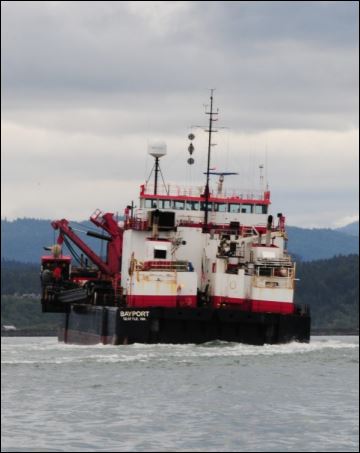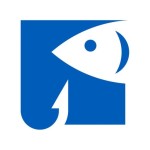Eel River - South Fork Fish Report for 6-6-2017
Dredging up an answer
Eel River - South Fork - CA

by Casey Allen
6-6-2017
We have two serious yet separate dredging issues in Humboldt Bay. Both are largely caused from sediment produced by the Eel River. The first is the heavy, large particles that flow on the winter currents that surge north. The heavy sediment collects in the entrance of Humboldt Bay after confronting the jetties. This results in shoaling where sand piles up creating a bar that limits deep draft ships from entering the bay and creates dangerous waves that threaten smaller craft. Each spring, the Army Corps of Engineers (ACOE) contracts a large dredge to scoop up the sand and deposit it offshore. It normally costs around $4.5 million each year but in 2015 the shoaling was so bad the costs soared to $7.5 million.
During the mid 1990s, the ACOE and others came up with a number of options for a long term sediment management plan. They ranged from continued dredging, to collection pits to trap the sediment offshore, to barrier reefs to redirect the sediment away from the harbor entrance. HASA supports the sediment barrier reef option utilizing derelict barges and other material because it could deflect the sediment to deeper water, reuse the derelict barges, and create rockfish habitat. The ACOE needs a three year, $3 million study to decide which option is best. They have asked the Harbor District to split the cost of the study. I feel the Harbor District should not be asked to put up $1.5 million, which they don’t have. The ACOE is spending millions in dredging costs and could save much of that with a long-term solution. In the meantime, nothing is happening except the sediment is still moving and dredging is still occurring.
This year, some entrance and channel dredging has been contracted, but not enough funding is available for what is needed. Work to secure more funding is ongoing but there is a lot competition from other West Coast ports that are also in dire need of dredging.
The second issue is caused by the small, light sediment particles that suspend in the water column and ride the current and tides into Humboldt Bay from offshore sources, from streams entering Humboldt Bay, and wind generated sediment from the mud flats. The muddy water flows into the bay and the light sediment settles to the bottom in the upper reaches of the bay and eddies where the current slows. This includes locations like the marinas, boat ramps, and any other calm spots. It also settles in the channels during slack tide, but the tidal currents flow enough to lessen the buildup. This material has historically been removed by a suction dredge and deposited on the beach to be dissipated by the waves or temporarily deposited in upland fill sites.
Studies estimate the Eel River produces an average of 2.3 million cubic yards of sediment per year that reaches the ocean. The river sediment is caused by heavy rain, erosion, and human activities like logging, road building, gravel mining, and other agriculture. When the sediment reaches the ocean, typically in winter, the currents along the beach flow north. During the summer and low river flows, the beach currents are slower and flow south. The streams that flow directly into Humboldt Bay do not contribute nearly as much sediment as the Eel and Mad rivers. There is also some redistribution of sediment during windy periods when the bay is frothed; stirring up the mud and the tide moves it elsewhere.
In 1998, the Environmental Protection Agency (EPA) issued a permit to dredge the light sediment from Humboldt Bay and deposit it on the beach. In 2007, the 10 year dredging permit was still in effect and the sediment was again disposed of on the beach. This time there was substantial opposition from Baykeeper and Surfriders. An agreement was made to never use beach disposal again, and the Harbor District was tasked with finding an alternate disposal method. It is unclear if this was a binding agreement but Baykeeper and the Surfriders are still opposed to beach disposal and the EPA has indicated they would not permit beach disposal. Their argument is beach disposal denies access and wrecks the aesthetics for beach goers during the period of beach disposal.
Now 10 years later, the fine sediment has again inundated the marinas, boats are sitting on the mud, and the boat launch ramps are unusable at low tide. Commercial fishermen are moving to Crescent City and the tall ships that visit during the summer tourist season may not return. The Harbor District has been busy, but has not nailed down an alternative dredge disposal method that has support from both the community and regulatory agencies. Now we are in crisis.
On May 3rd 2017, the Harbor District and City of Eureka held a meeting at the Warfinger Building to discuss the options for fine sediment dredging. The discussion was led by Miles Slattery from the City of Eureka and Jack Crider, CEO of the Harbor District. They described each option for dredge disposal, the associated costs and environmental impact. They said the beach disposal was the most efficient and environmentally friendly disposal method. But because of the prior agreement and objections from Baykeeper, Surfriders, and the EPA, that option appears to have been taken off the table.
The next best option was in-bay disposal where the dredge spoils are moved into the flow lane or shipping channel, a large proportion would naturally flush out of the bay on the outgoing tide, with the remaining heavy sediment being scooped up and taken offshore by the ACOE dredge. This method is used in many ports on the West Coast, but the ACOE is working to move away from this method due to funding limitations. Another problem is that the spoils are too fine and there is no opportunity to remove the beer bottles and other garbage before it is taken offshore.
The other options were pumping the dredge spoils to upland disposal sites. This was the most costly option as the material would have to be handled more than once. The spoils would be moved to a contained site for de-watering and then removed to be used at some restoration project. Unfortunately, the EPA has identified the material as too fine to be reused in most restoration projects even though it is the same material deposited on local beaches by the Mad and Eel Rivers.
The upland sites each have their own drawbacks. The site called the “superbowl” near the Samoa Airport and drag strip was created for dredge spoil disposal but now has an endangered plant growing there. White’s Slough cannot receive the large amounts of dredge spoils, and the pumping distance from Eureka marinas makes it expensive to purchase the pipe and pumps necessary to get the sediment to the south bay. The most likely place is the Samoa Lagoons that are located between the Samoa Bridge and the turnoff to the Samoa Cookhouse. Of course, that is one of the most expensive locations as the existing lagoons will need to be cleaned out to make room for the new spoils and the dewatering will have to go through clarifiers before being pumped back into the bay. Its limited volume may require dredging to be spread over a few years.
The use of the ocean outfall pipe from the pulp mill is possible, but will incur large capital costs. It would also take space in the pipe more suited to other uses, like transoceanic fiber telecommunications cables, wave generated electric cables, and a grey water disposal pipe from the City of Eureka (this would improve overall water quality in the bay).
The Harbor District and City of Eureka have been working on this every day and recently had a meeting with all the permitting agencies except the EPA. From my sources, it appeared the agencies present were close to agreement that beach disposal was best, because of the large amount of material to be dredged, around 230,000 cubic yards. But the EPA announced in a later conference call that they could not grant a permit for beach disposal because it would be a violation of law.
Once this large amount of dredging is completed, it should be affordable to maintain a dredging cycle with the new dredge, utilizing upland disposal sites. There are projects on the horizon that may be able to reuse the material, but we can’t wait for them. The community is losing revenue as we struggle with this crisis.
The Harbor District has been criticized for seemingly doing nothing since the 2007 dredging agreement that tasked the District to find an alternate disposal method. But since then, they changed CEO’s, saved the bay from disaster by acquiring and cleaning up the pulp mill, acquired and refurbished a suction dredge, and overcame the unprecedented and extreme shoaling at the bay entrance in 2015. All this, while slowly improving their economic outlook.
It appears to me the solution will be a political one. When the agencies are at odds or the laws prohibit doing the right thing or the situation is so dire the cost is unaffordable, then it is up to our elected officials to find an answer. You can help by reminding them how important a working bay is to the entire community.
The mission of Humboldt Area Saltwater Anglers is to represent North Coast fishermen's historic and ongoing right to sport fish along the Northern California coast; advocate reasonable and rational sport fishing seasons and regulations; educate our members and the general public about the economic and cultural contributions of sport fishing to our local economies; and promote sustainable stewardship of the resource.

Website Hosting and Design provided by TECK.net
